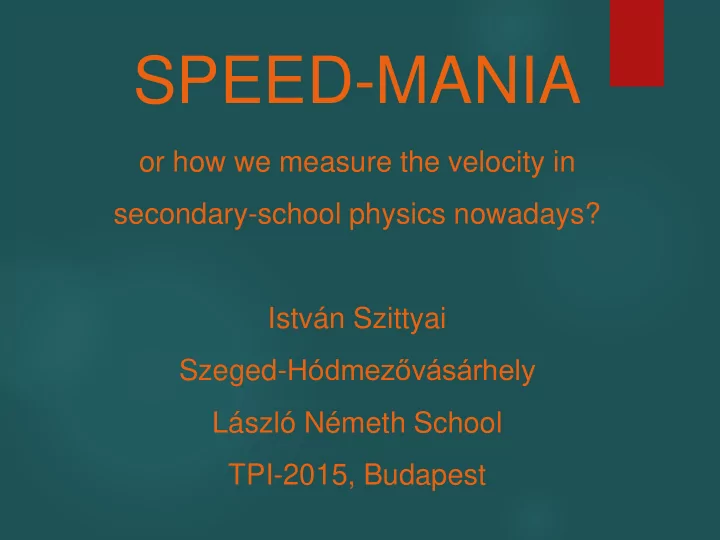

SPEED-MANIA or how we measure the velocity in secondary-school physics nowadays? István Szittyai Szeged- Hódmezővásárhely László Németh School TPI-2015, Budapest
Digital measurements Grammar and High School „Németh László”, Hódmezővásárhely ELTE Physics Education Program (2013- ) Supervisor: prof. István Groma Support: Noise Group (Univ. Of Szeged) Research topic: Digital measurements in the physics education Systematically look for „ Where? What? How ?” can we Romania use Favorite: the measurements, that is (nearly) impossible Croatia Serbia with traditional (classical?) methods
Digital measurements Observation: this have additonal motivation for students! Main difficulty: usually quite expensive … These devices, instruments and methods are still spreading: Öveges-program (renewal of the science education) Geomatech-project (GeoGebra + some new methods) Some other projects and funds There are some cheap solutions, for example EDAQ 530 Developed by „ Noise Group”, University of Szeged low-cost, compact and easy-to-use digital measurement solution for schools
EDAQ 530 – Noise Group SZTE • Developed in 2009-2010 • A/D converter, 12-bit, with 3 channels • Sensors, as you want • IR-photo-gate, pressure, acceleration, Hall-sensor, termistors , … • The software is free • The hardware documentation is also free • Education development projects
Velocity and speed The concept of velocity is not an easy notion in secondary school One of the first notions of physics at the age 12-13: speed=distance/time, 𝑤 = 𝑡 𝑢 Distance, position, displacement … Instantaneous velocity: 𝑤 = ∆𝑦 ∆𝑢 , if ∆𝑢 is „ very small ” (Velocity is a vector … now irrelevant)
Measuring velocity with IR-photogate Rod, straw on the moving object (thickness: 𝑒 ) • • Level-crossing detector „ on ” ( in the software) Speed is calculated from ∆𝑢 and 𝑒 • !!! We measure the inst. velocity !!! • (if d is small enough …)
Foucault-pendulum (period, grav. constant, energy loss)
Group of students (age 12-13), measuring the velocity with photo-gate
Ruler with insulating tape Measuring acceleration! (in particular: )
Ultrasonic motion sensors
The software generate the velocity-graph from the distance-graph Collison on the air track (2 gliders, moving in the same direction)
Motion on a slope (air track with a spring on the bottom
Measuri suring ng ref efracti active in index x - - speed eed of of li light ht in in li liquids uids WITH LASER DISTANCE MEASURE
The instrument Model: Toolcraft LDM 50 T Red laser ( 𝜇 = 650 nm ) Range: 5 cm – 50 m Accuracy: ±1.5 mm Operation: time-of-flight principle ( 𝑡 = 𝑑𝑢) 20 results can be stored Continous measurement
The method and notations The speed of light in air: 𝒅 The inner height of the tube: 𝒆 The height of water: h Flight time: 𝒖 (or 𝒖/𝟑 ) The value measured by the instrument: 𝒕(> 𝐞 ‼ ). (Clearly: 𝑡 = 𝑑𝑢) 𝒆 Refractive index of water: 𝒐 𝒊+(𝒕−𝒆) Some computation: 𝒐 = 𝒊 𝒊 𝒅 𝒕 𝒊 = 𝒘 − 𝟐 𝒊 + 𝒆 = 𝒐 − 𝟐 𝒊 + 𝒆
A mérési elrendezés
Refractive index of water s(h) diagram 0.700 s = 0,3486h + 0,5251 0.650 0.600 S (m) 0.550 0.500 0.450 0 0.05 0.1 0.15 0.2 0.25 0.3 0.35 0.4 0.45 h (m) n=1.3486
Refractive index of some other liquids • With the same method Vegetable oil: 𝑜 ≈ 1.47 • Glycerol: n ≈ 1.48 •
Measuring the speed of sound DIRECTLY WITH SOUND INTENSITY SENSORS
Speed of sound in air If you have two sensors, connected to a date-logger The distance: 𝑒 Make some sudden noise from the side Thanks to the high sampling rate we can determine the delay ( Δ𝑢) between the signs And from this, calculate the speed: 𝑑 = 𝑒/Δ𝑢 Its simple, fast and accurate enough in school In water?? In other gases?
Speed of sound in carbon-dioxid • Inge H.A. Pettersen: Speed of Sound in Gases Using an Ultrasonic Motion Detector, The Physics Teacher 40 , 284 (2002) Calibration of the ultrasonic detector: 343 𝑛/𝑡 at 20℃ • The speed in 𝐷𝑃 2 : 268 𝑛 𝑡 (at 24℃ ) • Investigation of temperature variations in the speed •
Result graph
Thank you for your attention!
Recommend
More recommend